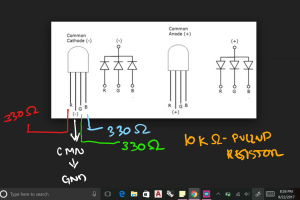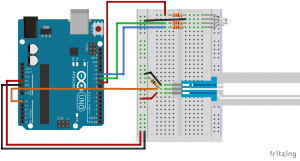In this demo I wanted to understand how an analog tool, such as a soft potentiometer could change the color of an RGB Led. I also made an attempt to connect sound through the use of a piezo buzzer in association with a change in the color, but was unsuccessful in the output.
In the demo video the RGB led is not visible. To optimize the ability to notice the change in color I placed a foam cube on top of the led to slow the diffusion of the light.
Video Player



The circuit was created with help from a few websites noted in the code below.
1 2 3 4 5 6 7 8 9 10 11 12 13 14 15 16 17 18 19 20 21 22 23 24 25 26 27 28 29 30 31 32 33 34 35 36 37 38 39 40 41 42 43 44 45 46 47 48 49 50 51 52 53 54 55 56 57 58 59 60 61 62 63 64 65 66 67 68 69 70 71 72 73 74 75 76 77 78 79 80 81 82 83 84 | // Help from SparkFun guide to use of a soft potentiometer and HackerScapes<blockquote class="wp-embedded-content" data-secret="dx92tJKxXG"><a href="http://www.hackerscapes.com/2014/11/buzzer-reacts-to-a-specific-rgb-led-color/">Buzzer Reacts to a Specific RGB LED Color</a></blockquote><iframe class="wp-embedded-content" sandbox="allow-scripts" security="restricted" style="position: absolute; clip: rect(1px, 1px, 1px, 1px); width: 1264px; height: 712.053px;" src="http://www.hackerscapes.com/2014/11/buzzer-reacts-to-a-specific-rgb-led-color/embed/#?secret=dx92tJKxXG" data-secret="dx92tJKxXG" width="600" height="338" title="“Buzzer Reacts to a Specific RGB LED Color” — HACKERSCAPES" frameborder="0" marginwidth="0" marginheight="0" scrolling="no" data-origwidth="600" data-origheight="338"></iframe>//Create a system where a spectrasymbol soft potentiometer changes the color of an RGB light.// setup pins for rgb color constants (Digital Pins) const int SoftPotentiometer_PIN = 0; // Analog input pin a0const int RED_COLOR= 8;const int GREEN_COLOR= 9;const int BLUE_COLOR= 10;int PIEZO_sound = 12;int PIEZO_value = 0;// Global variables for Pulse with Modulation values of the RGB LED.For interpretation in the rgb function and loop.//PWM controls the LED brightness, the color becomes mixed when dimming in different amounts.int redValue, greenValue, blueValue;void setup(){pinMode(RED_COLOR, OUTPUT);pinMode(GREEN_COLOR, OUTPUT);pinMode(BLUE_COLOR , OUTPUT);pinMode(PIEZO_value, OUTPUT);Serial.begin(9600); // serial communication at bits/second} void loop(){// Soft Potentiometer Value, analog input value ranges from (0-1023)int pValue;pValue = analogRead(SoftPotentiometer_PIN);setRGB(pValue); // set the rgb led color to potentiometer value// or > for (>) and <(<) / & ... syntax???// some reason the syntax below did not create an "not declared" error message.if (pValue > 0 , pValue <=200){digitalWrite(PIEZO_value,HIGH);// turn on piezo buzzer sound}else:digitalWrite(PIEZO_value, LOW); // if minimum voltage not recieved or larger, no sound from the piezo buzzer.}// begin setting up sections of the potentiometer for different color "peaks."void setRGB(int RGBposition){int mapRGB1, mapRGB2, constrain1, constrain2;// (Red at 0 and the midpoint)mapRGB1 = map(RGBposition, 0, 341, 255, 0);constrain1 = constrain(mapRGB1, 0, 255);mapRGB2 = map(RGBposition, 682, 1023, 0, 255);constrain2 = constrain(mapRGB2, 0, 255);redValue = constrain1 + constrain2;// Green at 341// (one-third of the way to 1023):greenValue = constrain(map(RGBposition, 0, 341, 0, 255), 0, 255)- constrain(map(RGBposition, 341, 682, 0,255), 0, 255);// Blue at 682// (two-thirds of the way to 1023):blueValue = constrain(map(RGBposition, 341, 682, 0, 255), 0, 255)- constrain(map(RGBposition, 682, 1023, 0, 255), 0, 255);analogWrite(RED_COLOR, redValue);analogWrite(GREEN_COLOR, greenValue);analogWrite(BLUE_COLOR, blueValue);} |
Leave a Reply
You must be logged in to post a comment.